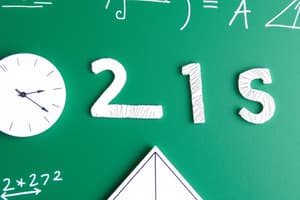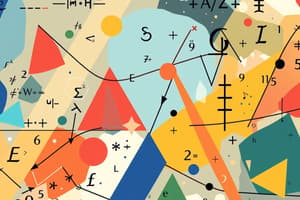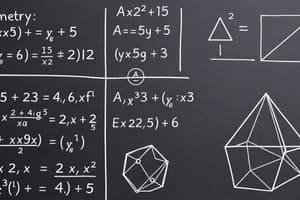Podcast
Questions and Answers
Which operation is not included in basic arithmetic?
Which operation is not included in basic arithmetic?
- Graphing (correct)
- Multiplication
- Subtraction
- Addition
What is the Pythagorean theorem primarily used for?
What is the Pythagorean theorem primarily used for?
- Finding the circumference of a circle
- Calculating the length of sides in a right triangle (correct)
- Measuring angles in a polygon
- Determining the area of a triangle
Which of the following best describes a derivative in calculus?
Which of the following best describes a derivative in calculus?
- A rate of change at a point (correct)
- A measure of area under a curve
- A sum of functions
- A classification of statistical data
What does the Law of Sines relate to?
What does the Law of Sines relate to?
In statistics, which measure represents the middle value of a data set?
In statistics, which measure represents the middle value of a data set?
Which area of mathematics focuses on logic and set theory?
Which area of mathematics focuses on logic and set theory?
Which concept applies to the probability distribution of a data set?
Which concept applies to the probability distribution of a data set?
What technique is used to prove mathematical statements through contradiction?
What technique is used to prove mathematical statements through contradiction?
Which of the following is a fundamental principle in trigonometry?
Which of the following is a fundamental principle in trigonometry?
What is a key study tip for mastering mathematics?
What is a key study tip for mastering mathematics?
Flashcards are hidden until you start studying
Study Notes
Key Areas of Mathematics
-
Arithmetic
- Basic operations: addition, subtraction, multiplication, division.
- Concepts: integers, fractions, decimals, percentages.
-
Algebra
- Variables and constants.
- Expressions, equations, and inequalities.
- Functions and graphing.
- Polynomials and factoring.
-
Geometry
- Properties and relationships of shapes (2D and 3D).
- Theorems (e.g., Pythagorean theorem).
- Measurements: area, volume, perimeter, and circumference.
- Angles and their classifications (acute, obtuse, right).
-
Trigonometry
- Definitions of sine, cosine, and tangent.
- Right triangles and the unit circle.
- Applications of trigonometric functions.
- Laws: Law of Sines and Law of Cosines.
-
Calculus
- Limits and continuity.
- Derivatives and their applications (slope, rates of change).
- Integrals and area under curves.
- Fundamental Theorem of Calculus.
-
Statistics
- Data collection and analysis.
- Measures of central tendency: mean, median, mode.
- Measures of variability: range, variance, standard deviation.
- Probability concepts and distributions (normal, binomial).
-
Discrete Mathematics
- Logic and set theory.
- Combinatorics: permutations and combinations.
- Graph theory and network analysis.
- Algorithms and complexity.
-
Mathematical Reasoning
- Inductive and deductive reasoning.
- Proof techniques: direct proof, contradiction, contrapositive.
- The role of conjectures in mathematics.
Applications of Mathematics
- Real-world problem solving: finance, engineering, computer science.
- Statistical analysis in social sciences and health.
- Mathematical modeling in natural and social sciences.
Study Tips
- Practice regularly to reinforce concepts.
- Work on problem sets and exercises.
- Understand the underlying principles rather than just memorizing formulas.
- Use visual aids like graphs and charts for better comprehension.
- Join study groups for collaborative learning.
Arithmetic
- Fundamental operations include addition, subtraction, multiplication, and division.
- Numbers are categorized as integers, fractions, decimals, and percentages.
Algebra
- Variables represent unknown quantities, while constants have fixed values.
- Expressions, equations, and inequalities are used to express relationships between variables.
- Functions illustrate input-output relationships, often visualized through graphs.
- Polynomials are expressions containing multiple terms with variables raised to different powers, and factoring involves breaking them down into simpler components.
Geometry
- Geometry explores the characteristics and connections of shapes in two and three dimensions.
- Key principles like the Pythagorean theorem define relationships between sides in right triangles.
- Calculations of area, volume, perimeter, and circumference are fundamental for understanding shape properties.
- Angles are classified based on their size, including acute (less than 90 degrees), obtuse (greater than 90 degrees), and right (exactly 90 degrees).
Trigonometry
- Trigonometric functions like sine, cosine, and tangent relate angles and sides in right triangles.
- The unit circle provides a framework for visualizing and understanding trigonometric functions.
- These functions have applications in various fields, including physics, engineering, and navigation.
- The Law of Sines and Law of Cosines are key tools for solving problems involving triangles.
Calculus
- Calculus focuses on change and motion by analyzing limits and continuity.
- Derivatives measure rates of change and provide information about slopes, while integration calculates areas under curves.
- The Fundamental Theorem of Calculus establishes a crucial connection between derivatives and integrals.
Statistics
- Statistics involves collecting, analyzing, and interpreting data.
- Measures of central tendency (mean, median, mode) describe the typical value within a dataset.
- Measures of variability (range, variance, standard deviation) indicate the spread of data around its center.
- Probability concepts and distributions, such as the normal and binomial distributions, are used to model and understand random events.
Discrete Mathematics
- Logic and set theory provide tools for reasoning about mathematical objects.
- Combinatorics explores arrangements and selections using permutations and combinations.
- Graph theory focuses on networks and their properties, while algorithms and complexity deal with efficient problem solving.
Mathematical Reasoning
- Inductive reasoning uses patterns to make generalizations, while deductive reasoning applies known facts to reach conclusions.
- Proof techniques like direct proof, contradiction, and contrapositive are employed to establish mathematical truths.
- Conjectures are proposed statements that require further investigation to confirm or refute.
Studying That Suits You
Use AI to generate personalized quizzes and flashcards to suit your learning preferences.




